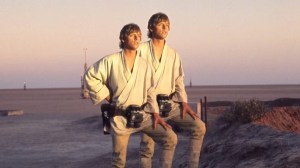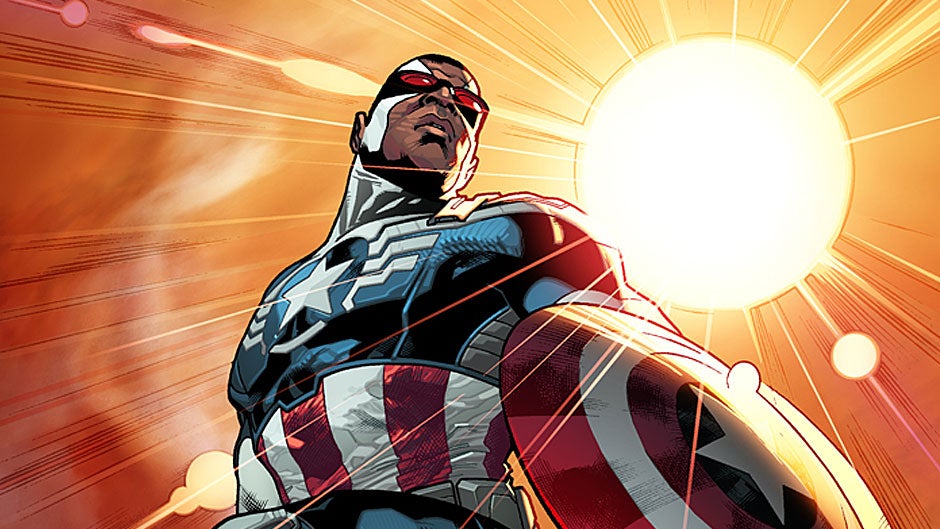
After first teasing a new Captain America over 4th of July weekend, Marvel Chief Creative Officer Joe Quesada announced on The Colbert Report that Samuel Wilson, better known as his superhero alias, the Falcon, would be assuming the red, white and blue mantle. This historic changing of the guard is the latest landmark event in Falcon’s publication history.
Videos by ComicBook.com
Created by Stan Lee and Gene Colan in 1969’s Captain America #117, Wilson is notable for being the first African American superhero created by a mainstream comic book publisher (Black Panther, who was introduced a few years earlier, is a native of the fictional African country Wakanda).
Over the span of his more than 40-year career, Falcon would co-headline a series with Captain America (starting with issue #134), join the Defenders and later the Avengers (before quitting both and rejoining the latter years later), briefly fill-in for Captain America as head of the Secret Avengers during Civil War, and then play a key supporting role during the critically acclaimed Ed Brubaker/Steve Epting Captain America run (which includes “The Winter Soldier” and “Death of Captain America” arcs). He’s never headlined his own ongoing series, though he was the main focus of the Jim Owsley-scripted Falcon four-part miniseries in 1983-84. He was portrayed by Anthony Mackie in this year’s Captain America: The Winter Soldier film.
For those who want to catch up on some of Falcon’s career highlights in advance of his new beginning as Captain America, here are five essential storylines that feature the character.
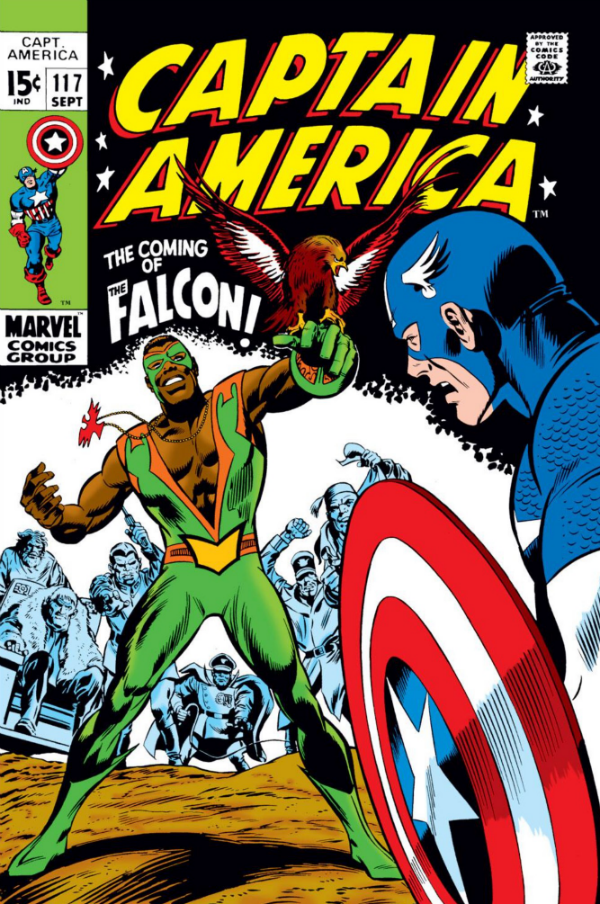
1. “The Coming of the Falcon” (Captain America #117-119)
Wilson debuted as the Falcon in this three-part storyline making comic book history and finally giving Captain America a long-needed sidekick (he had been mourning the death of Bucky Barnes since Cap was retinroduced in the Silver Age in Avengers #4).
In terms of first appearances, Lee and Colan throw Wilson into the deep end of the pool right away. At the start of the storyline, Wilson is living on Exile Island, a home base for minions of the Red Skull. The Skull uses the Cosmic Cube to transport himself and Captain America (who have switched bodies) to the island, in hopes of getting some assistance from his Exile supporters. As it turns out, while battling the Skull, Cap actually gets an assistantance from a bird – a falcon named Redwing. We would later discover that the Cube gave Wilson the power to telepathically communicate with Redwing.
Once Cap and Wilson meet, the two immediately become friends. Captain America starts training Wilson, helping him realize the extent of his new powers. Together, Cap and Falcon take down the Red Skull and a superhero partnership is born.
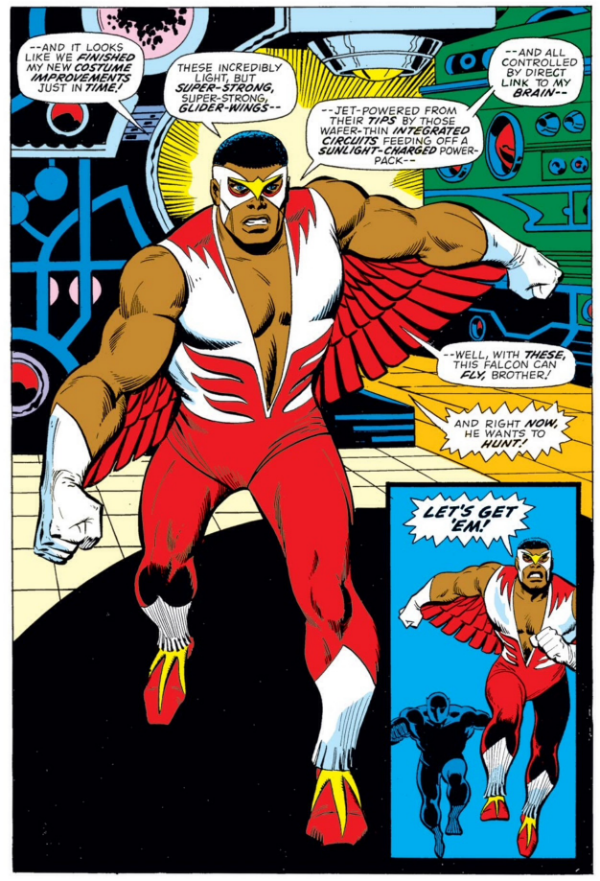
2. The Gift of Flight and “The Secret Empire” (Captain America and the Falcon #169-175)
An ongoing theme throughout the early Captain America and Falcon series was Wilson’s feelings of inadequacy and self-doubt, especially he compared himself to his super soldier, first class partner.
In the midst of Steve Englehart-scripted “Secret Empire” arc – which saw Captain America get framed as part of a larger government conspiracy – Wilson aligns himself with the Black Panther in an effort to expand his powerset and become a more useful ally. The end result of this alliance is a brand new costume for Wilson, which includes a harness and a set of mechanical wings that give him the ability to fly via a direct link to his brain.
The wings end up being the perfect antidote for Wilson’s one person pity-party and the timing could be better; in a few issues, Steve Rogers would quit being Captain America and Falcon would go on to train his temporary replacement, Roscoe, who is later killed by the Red Skull. Meanwhile,
Wilson’s new embellishments, as introduced in Captain America and Falcon #170, are a critical and consistent part of Falcon’s arsenal moving forward, as almost every future iteration of his costume includes these wings (including the cinematic adaptation of the character in Captain America: The Winter Soldier).

3. Rejecting the Avengers (Avengers #183-194)
After being Captain America’s sidekick for more than a decade, one would think that Wilson would have been granted full-fledged membership into the Avengers without a second thought. However, in a bit of meta-commentary about the state of diversity in the comic book industry, this honor wasn’t bestowed upon the Falcon until the late 70s when U.S. government superhero liaison Henry Peter Gyrich recruits Falcon explicitly to fill an African American quota on the team.
Wilson is none too happy about the circumstances surrounding his initiation into the Avengers, telling Cap that he’s not a fan of being anybody’s “token.” Cap convinces Falcon that he has a higher duty to fulfill and that he should stick it out.
Wilson’s loner attitude causes friction within the group, especially among some of the team’s more cantankerous members like Hawkeye. When Wonder Man, another superhero “minority” is brought onto the team in Avengers #194, Wilson promptly hands in his resignation, claiming he’s no longer needed to fill a quota. Falcon would later join the Avengers under more amenable circumstances as part of the Marvel’s post-Heroes Reborn third volume of the series in the late 90s/early 2000s.
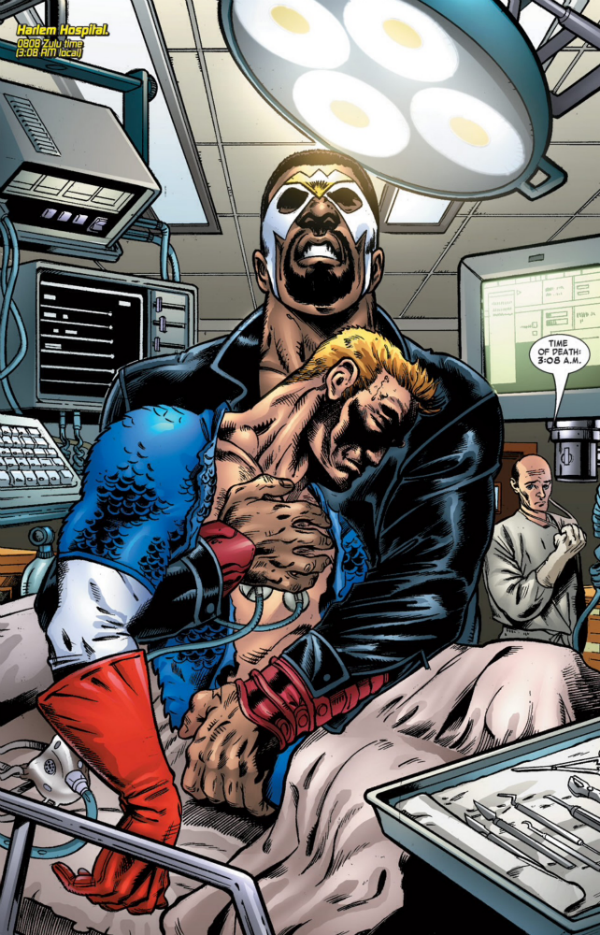
4. “American Psycho” (Captain America and Falcon #13-14)
While the 2004-05 Captain America and Falcon series was rife with behind-the-scenes conflict between creators Christopher Priest and Bart Sears, towards the latter stages of the run a somewhat heartwarming story is produced that really hones in on the unbreakable bond between Captain America/Falcon.
Around this time storyline-wise, Wilson’s mind has been destabilized by Wanda Maximoff, aka the Scarlet Witch, during “Avengers Disassembled.” As a result, Falcon reverts back to his prior criminal persona, Snap Wilson. His surly and arrogant attitude causes an obvious rift between him and Captain America, and after Cap confronts Wilson about his actions, Falcon quits the partnership for good.
Just as the two finish their argument, a former criminal associate of Wilson’s fires a gun, and the stray bullet hits Captain America. Cap is even believed to be dead for a quick minute, before he is upgraded to “living” and eventually recovers.
In the wake of these events, Wilson starts to regain his old persona and reevaluates his life. He quits being Falcon for a brief period, but is eventually brought back into the fold for the House of M and Civil War events.

5. “The Burden of Dreams” and “The Man Who Bought America” (Captain America vol. 5 #31-42)
In the aftermath of Captain America’s shocking assassination in 2005, Wilson decides to register his identity in accordance with the Superhero Registration Act. But Falcon is soon asked to play a critical part in the birth of a second Captain America, Cap’s former sidekick Bucky Barnes, who had been surprisingly resurrected as part of Ed Brubaker/Steve Epting’s “Winter Soldier” storyline (of which the film of the same name is based off of).
Wilson is sent out to find Barnes, and rescues him after being dumped out of a air carrier by Doctor Faustus and Red Skull. Bucky appears to be arrested by S.H.I.E.L.D. but instead he is approached by Tony Stark, leader of the pro-registration movement, about becoming the new Captain America. Barnes reluctantly agrees under the condition that he does not have to report to Stark or S.H.I.E.L.D.
As he did with Steve Rogers, Wilson supports Bucky on his first mission, teaming up with him and the Black Widow to take down the Red Skull, who is trying to infiltrate the American political system with a brainwashed presidential candidate. Widow and Falcon ultimately lead the S.H.I.E.L.D. raid that breaks up the Skull’s compound and sends the nefarious villain on the run.


